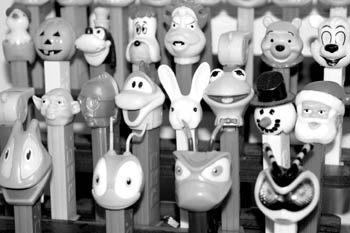![[Metroactive Features]](/features/gifs/feat468.gif)
[ Features Index | Silicon Valley | Metroactive Home | Archives ]
Museum of Pez Memorabilia
By Corinne Asturias
THE PEZ MUSEUM does a brisk business, and even on a sleepy weekday morning a steady trickle of tourists and curious passersby wanders into the unassuming storefront on California Drive in Burlingame. Being the only such museum in the world has its advantages. "I have people coming in here from as far away as Japan," says owner Gary Doss. "Even if they don't speak a word of English, they'll say, 'Mary Poppins,' perfectly. When you speak the language of Pez, just a few words are enough."
Like a zoologist at a zoo, Doss knows the names of all the hundreds of collectible (and valuable) Pez candy dispensers and accessories in his shop, even the names that make no sense, like "Astronaut B" from the early '60s, which is today worth a small fortune. From the Flintstones to the Smurfs to Star Wars, Pez incarnations represent a time machine of kiddie pop culture, and in Doss' museum, they are all there carefully preserved in Plexiglas cases.
The museum contains well-preserved artifacts of Pez' early era, including vending machines, posters, space guns, picture frames and dolls, as well as the .holy grail of Pez dispensers: the highly sought after "Make a Face" Pez, which, during its minuscule life span, came with detachable eyes, nose, ears and facial parts, kind of like Mr. Potato-head. Because its tiny parts were determined to constitute a choking hazard, the product was ordered pulled from shelves and destroyed. Today, a genuine "Make a Face" Pez in its original packaging, such as the one Doss has on display at the Pez museum, sells for about $4,500, if you could get anyone to part with it.
Doss also sells new stuff, like the Jungle Book 2 set, the new Mr. Bean set from Europe (complete with Mini Cooper) and a giant Homer Simpson Pez whose mouth is so big it dispenses entire packs and says, "D'oh!" There are furry Pez, Swarovski Crystal-covered Pez (at $120 a pop), Pez flashlights, Pez key rings and the still-waiting-to-catch-on bag-o-juice Pez from Canada.
Doss himself is a font of Pez trivia. What are the flavors of Pez in the United States? Lemon, orange, strawberry, grape and peppermint. What are the flavors in Europe? They also have raspberry, cherry and a very tasty "cola" flavor that the United States does not. How many different Pez dispensers have been made? 320. Where does the word Pez come from? It's an abbreviation of the German word pfefferminz, which means peppermint.
Pez was invented by Austrian businessman Eduard Haas in 1927, as a breath mint sold in little boxes or tins. In 1949, it was packaged in a headless plastic case that looked kind of like a cigarette lighter. In 1952, Pez dove headfirst into the kiddie market by introducing a Mickey Mouse and a Popeye Pez. The plastic heads started tilting back in record numbers, and the rest is history.
Bitten by the Pez bug 15 years ago, Doss says he originally brought in his collection simply to brighten up the décor of his small computer store, but the Pez quickly took on a life of their own. He now says proudly, "This is all I do," mentioning that today his computer supplies fill one small shelf.
For all of its popularity and cult status in the United States and beyond, Doss says, the original Pez factory in Austria doesn't offer tours, maintain a historical display or keep a lobby museum. In fact, the home of Pez doesn't seem very enamored with itself at all for having created one of the most memorable toy-candy experiences in the world outside of Cracker Jack.
The Austrian candy maker recently and rather unceremoniously sold its original neon Pez factory sign on eBay. Doss says he was the only bidder and picked it up for a mere $300, less than the price of four Pez space guns from the '50s (although the shipping was $500). "They are only in the business of making and selling candy," Doss says with a shrug.
Favorite Local Collections
Rite of Pez-age: The Museum of Pez Memorabilia in Burlingame.
The Hole Truth: Lou's Living Donut Museum in San Jose.
Composing a Life: The Ira F. Brilliant Center for Beethoven Studies at San Jose State University.
Waste Not: The Garbage Museum in Milpitas.
Lofty Ambitions: The Wings of History Museum in San Martin.
High-Tech Hit Parade: The Intel Museum in Santa Clara.
History Lesson: The Japanese-American Museum of San Jose.
Beyond the Doily: The Lace Museum in Sunnyvale.
Museums: A complete guide to local museums.
[ Silicon Valley | Metroactive Home | Archives ]
![]()

Rite of Pez-age
Museum of Pez Memorabilia Hours: Tue-Sat, 10am-6pm. Admission: Free. 214 California Dr., Burlingame; 650.347.2301. www.spectrumnet.com/pez/
Send a letter to the editor about this story to letters@metronews.com.
From the March 13-19, 2003 issue of Metro, Silicon Valley's Weekly Newspaper.